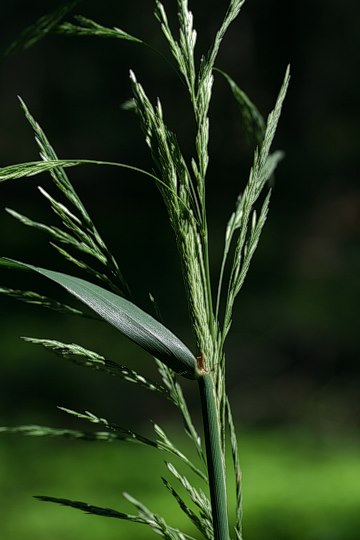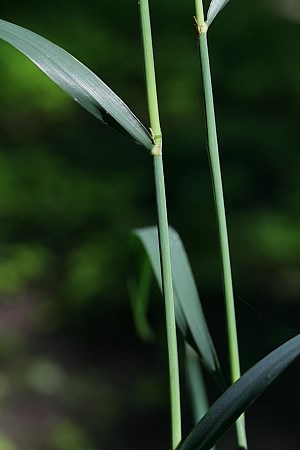Description: This perennial grass is 3-5' tall, consisting of individual or small tufts of erect culms with alternate leaves. The culms are terete, light green or light blue-green, and hairless. The nodes of the culms are slightly swollen, green, and glabrous. The leaf blades are up to 12" long and ½" across; they are greyish green or dull blue, hairless, and often droop toward their tips. The leaf sheaths are similar in color to the blades, hairless, and veined. At the junction of the blade and sheath, each ligule has a conspicuous papery membrane.

Each culm
terminates in a greyish green inflorescence up to 12" long and 5"
across, consisting of a panicle of spikelets. The larger branches of
this panicle occur in whorls along the central axis; they ascend upward
for the most part, but tend to droop where they subdivide into smaller
branchlets. Both branches and branchlets are slender and hairless. The
smallest branchlets of the inflorescence terminate in single-flowered
spikelets. Each slender spikelet is about 5-6 mm. long, consisting of a
pair of glumes, a fertile lemma, and a palea enclosing the floret. Each
floret has a developing ovary, a single anther, and a pair of feathery
stigmas. One glume is longer than the other; the larger glume and
fertile lemma are nearly as long as the spikelet. The lemma often has a
minute awn that is less than 0.5 mm. in length. The blooming period
occurs during the late summer and the grains ripen during the fall, at
which time the entire inflorescence becomes light tan. Disarticulation
of the spikelets is below the glumes. The grains are narrow and
elongated. The root system is fibrous and rhizomatous. This grass is
commonly found as scattered individual plants or in small vegetative
colonies.
 Cultivation:
The preference is light shade to dappled sunlight, slightly wet to
consistently moist conditions, and fertile loamy soil with abundant
organic matter. Most growth and development occurs during the summer.
Cultivation:
The preference is light shade to dappled sunlight, slightly wet to
consistently moist conditions, and fertile loamy soil with abundant
organic matter. Most growth and development occurs during the summer.
Range & Habitat:
The native Stout Wood Reed has been observed in most counties of
Illinois (see Distribution
Map); it is common in the southern half of Illinois, and
occasional in the northern half of the state. Habitats include
floodplain woodlands, swamps, thickets, small woodland openings, seeps
in wooded areas, and damp savannas. Less often, this species can be
found in open areas, including fallow fields and strip-mined areas (in
southern Illinois). This woodland grass matures later in the year than
many other species of woodland grass. By late summer, it often towers
above the surrounding ground vegetation.
Faunal Associations:
Little is known about floral-faunal relationships for this species.
Cattle and other domesticated herbivores will eat this grass, but it is
rarely abundant enough in any single area to provide a significant food
supply. White-Tailed Deer usually leave this grass alone in wooded
areas as they prefer to eat forbs or browse the smaller branches of
woody vines and shrubs.
Photographic Location:
A low area of Busey Woods in Urbana, Illinois.
Comments:
Stout Wood Reed is tall and attractive. The only other member of its
genus in Illinois is Cinna latifolia (Drooping Wood
Reed), which has a more open and drooping inflorescence with shorter
spikelets (less than 5 mm. in length). The spikelets of Drooping Wood
Reed also have awns about 1 mm. in length. Both species have spikelets
that disarticulate below the glumes (i.e., their glumes don't persist
on the branches of the inflorescence at maturity), and there is only a
single anther per floret. This latter characteristic is unusual, as the
floret of a typical grass species produces 3 anthers. Another species, Phalaris
arundinacea (Reed Canary Grass), is somewhat similar in
appearance. This latter species has spikelets that disarticulate above
the glumes and it usually blooms earlier in sunny meadows and wetlands.
The inflorescence of Reed Canary Grass is more upright and less
inclined to droop.